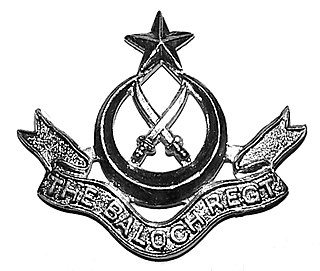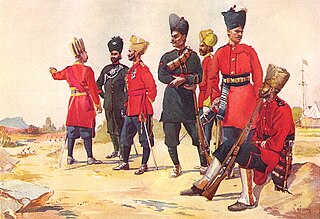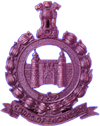
The 102nd Infantry Division ("Ozark") was a unit of the United States Army in World War II. The unit is currently active as the 102nd Training Division .
The Rajputana Rifles is the one of the most senior rifle regiments of the Indian Army. It was originally raised in 1921 as part of the British Indian Army, when six previously existing regiments were amalgamated to form six battalions of the 6th Rajputana Rifles. In 1945 the numeral designation was dropped from the title and in 1947 the regiment was transferred to the newly independent Indian Army. Since independence, the regiment has been involved in a number of conflicts against Pakistan, as well as contributing to the Custodian Force (India) in Korea under the aegis of the United Nations in 1953-54 and to the UN Mission to the Congo in 1962. As a rifle regiment it uses a bugle horn as its insignia, the same as the British Light Division, but unlike its British counterparts, the Rajputana Rifles march at the same march pace used in the Indian Army as a whole.

The Baloch Regiment is an infantry regiment of the Pakistan Army. The modern regiment was formed in May 1956 by the merger of 8th Punjab and Bahawalpur Regiments with the Baluch Regiment. Since then, further raisings have brought the strength of the Regiment to more than fifty battalions. The Baloch Regiment is descended from the infantry of the old British Indian Army and is named after the Pakistani province of Balochistan. Before 1991, it was called the Baluch Regiment but the spelling was changed to 'Baloch' to better reflect the correct pronunciation.

A pioneer is a soldier employed to perform engineering and construction tasks. The term is in principle similar to sapper.

The Bengal Army was the army of the Bengal Presidency, one of the three presidencies of British India within the British Empire.

20th Marine Regiment was an Composite Engineer Regiment of the United States Marine Corps that fought during World War II.

The 10th Baluch or Baluch Regiment was a regiment of the British Indian Army from 1922 to 1947. After the independence, it was transferred to the Pakistan Army. In 1956, it was amalgamated with the 8th Punjab and Bahawalpur Regiments. During more than a hundred years of military service, the 10th Baluch Regiment acquired a distinguished record amongst the regiments of the British Indian Army. Its list of honours and awards includes four Victoria Crosses.

The 104th Wellesley's Rifles were an infantry regiment of the British Indian Army. They could trace their origins to 1775, when they were raised as the 5th Battalion, Bombay Sepoys.
The 126th Baluchistan Infantry was an infantry regiment of the British Indian Army raised in 1825 as the 2nd Extra Battalion of Bombay Native Infantry. It was designated as the 126th Baluchistan Infantry in 1903 and became 2nd Battalion 10th Baluch Regiment in 1922. In 1947, it was allocated to the Pakistan Army, where it continues to exist as 7th Battalion of The Baloch Regiment.
The 121st Pioneers were an infantry regiment of the East India Company's Bombay Army and lather the British Indian Army. The regiment traces their origins to 1777, when they were raised as the Marine Battalion.
The 127th Queen Mary's Own Baluch Light Infantry was an infantry regiment of the British Indian Army raised in 1844 as The Scinde Bellochee Corps. It was designated as the 127th Baluch Light Infantry in 1903 and became 3rd Battalion 10th Baluch Regiment in 1922. In 1947, it was allocated to Pakistan Army, where it continues to exist as 10th Battalion of The Baloch Regiment.
The 252nd Indian Armoured Brigade was an armoured formation of the Indian Army. It was formed from the 3rd (Meerut) Cavalry Brigade when it was dispersed and reformed as the 2nd Indian Armoured Brigade in 1940, from July 1941 as 2nd Independent Armoured Brigade Group and the 252nd Indian Independent Armoured Brigade Group in December 1941. In January 1942 it was attached to the 10th Indian Infantry Division. Thereafter it served with the 31st Indian Armoured Division in the Middle East until being redesignated 2nd Indian Independent Armoured Brigade in December 1945. It returned to India in January 1946 and was redesignated 2nd Armoured Brigade [Independent] in June 1946.
The 3rd Sikh Pioneers was a regiment of the British Indian Army formed in 1922, when the Indian army moved from single battalion regiments to multi-battalion regiments. The 3rd Sikh Pioneers were one of four Pioneer units in the 1922 reorganisation, including the 1st Madras Pioneers, 2nd Bombay Pioneers, and 4th Hazara Pioneers.
The New Year Honours 1915 were appointments by King George V to various orders and honours to reward and highlight good works by members of the British Empire. They were announced on 1 January 1915.
The 155th Pioneers was a pioneer regiment of the British Indian Army. It was formed in Mesopotamia and Palestine in May and June 1918, saw service in the Sinai and Palestine Campaign in the First World War, and was disbanded in 1920.
The 1915 Birthday Honours were appointments by King George V to various orders and honours to reward and highlight good works by citizens of the British Empire. The appointments were made to celebrate the official birthday of The King, and were published in The London Gazette and in The Times on 3 June 1915.










